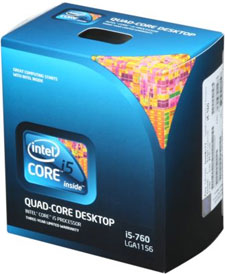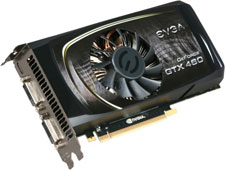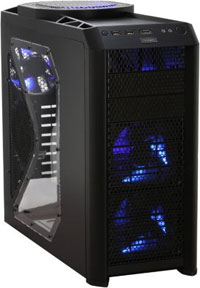Holiday 2010 System Builder's Guide
by AnandTech Staff, edited by Jarred Walton on November 19, 2010 2:00 AM EST- Posted in
- Guides
- Systems
- Holiday 2010
| Vivek's Midrange Intel System | ||
| Hardware | Component | Price |
| Processor |
Intel Core i5-760 Lynnfield 45nm (4x2.8GHz to 3.33GHz Turbo, 8MB L3, 95W) |
$200 |
| Motherboard | Gigabyte GA-P55-USB3 (Intel P55) | $120 |
| Video | EVGA GTX 460 768MB (768-P3-1360-TR) ($30 MIR) | $140 |
| Alternate GPU | ASUS GTX 460 768MB (ENGTX460 TOP)($20 MIR) | ($150) |
| Alternate GPU | ASUS Radeon HD 6850 1GB (EAH6850) | ($200) |
| Memory |
Corsair XMS3 2x2GB DDR3-1600 CL9 (CMX4GX3M2A1600C9) |
$65 |
| Hard Drive | WD Caviar Blue 1TB (WD10EALS) | $70 |
| Optical Drive | ASUS 24x DVDRW (DRW-24B1ST) | $20 |
| Power Supply | OCZ ModXStream Pro 700W (OCZ700MXSP) ($25 MIR) | $55 |
| Case | Antec Nine Hundred Two | $89 |
| Total System Price (Price based on GPU choice) | $759-$819 | |
When Jarred pitched his idea of a midrange gamer build, I liked the general idea except for one thing—the AMD processor. I'm more of an Intel guy at heart, so I tried to envision a similar midrange system built around an Intel platform. I built a very parallel system for personal use around this time last year, so I'll toss in a few anecdotes from my experience.

The processor was by far the easiest choice to make. At the price point we're looking at, the Core i5-760 makes the most sense. It's a quad-core Lynnfield running at 2.8GHz, with the only difference between it and the $280, 2.93GHz i7-860 being the clock speed bump and the lack of Hyper-Threading in the i5. Given that you've got four cores to work with, you won't miss the extra threading capabilities unless you're running some really highly threaded workloads. The 2.66GHz i5-750 is still kicking around at $199 (I can't believe that Intel has kept it at exactly the same price it was a year ago when I bought one!), but you can find the 760 for the same price. I figure it's not worth the $80 bump to the i7 line, as that money is better spent elsewhere.
For the motherboard, I went with the Gigabyte GA-P55-USB3. It's a rock solid board with USB 3.0 and a second PCI-E slot for CrossFireX support. In a mid-priced motherboard, there's not too much else you can ask for (except for maybe IEEE 1394). The Gigabyte P55 line has been popular since the launch of Lynnfield, and based on my experience I have no problems recommending it. As with Jarred's build, if you're serious about CrossFire you'll probably want to go with a different board that can do x8/x8 to the GPUs; as luck would have it, Biostar's T5 XE CFX-SLI has dual x8 slots and tosses in SLI support (via a PLX chip), and depending on the vendor it's even cheaper than the Gigabyte offering. Is it as reliable and does it have great support should something go wrong? We haven't had any serious issues with Biostar, but they can be a bit hit-or-miss.
RAM is kind of dependant on how much you need—I went with 4GB in my build last year and haven't felt short of memory, but I'm adding more this Black Friday just in case. For this build, I went with a Corsair XMS3 4GB (2x2GB) kit of DDR3-1600. Corsair's XMS3 was one of the more reasonably priced RAM kits on Newegg, but you can really go for whatever you feel comfortable with. I know a lot of people who like the G-Skill Ripjaws line, but they're rather pricey especially if you go for the 7-8-7-24 timings ($88 versus $75 for the 9-9-9-24 Ripjaws, and $65 for the XMS3s that also run at 9-9-9-24). Unless you have a specific preference for brand, you're probably better off going for whoever has the best sale.
Hard drives are another place where once you determine the capacity and speed, you're not going to get a whole lot of performance variation between different brands. I know people that swear by Seagate, I know some that swear by Western Digital, I know a lot that swear they hate either (or both), and there's Anand, who swears against hard drives on principle. In all honesty, I don't care either way, so I specced this system with the WD Caviar Blue 1TB 7200RPM drive, which at $69 is not a bad buy. There are 1TB drives from Seagate, Samsung, and Hitachi at the same price, so you're not at a loss for choice.

The graphics card is where things get interesting. If you're a serious gamer, I figure the lowest you want to go is the NVIDIA GTX 460 768MB. Most of those are going for $169, but the bog-standard EVGA GTX 460 listed above has a $30 rebate on top of that, and the more customized (and mildly factory-overclocked) ASUS ENGTX 460 comes with a $20 MIR. So if you don't mind the MIR, you can get away with a "low-end" GTX 460 for $140-150. Given the overclocking potential inherent to the GTX 460, that's a pretty good price.
But what if you want something faster? The best place to look is the HD 6850 (the 6870, at $240-300, is a bit too expensive for a midrange build). Ryan really liked the ASUS EAH6850 when he looked at the XFX, MSI, and ASUS retail HD 6850 cards earlier this month, and so it makes another appearance here. At $200, it's competitively priced against the rest of the HD 6850 partner cards, and it makes a good tradeoff between temperatures and noise. Like the ASUS ENGTX 460, it comes with a token overclock and ASUS' highly effective Direct CU cooler. It's faster than the comparably priced 1GB GTX 460 cards, so it's a worthwhile upgrade to make if you'll make use of the extra graphics horsepower on hand.
Of course, now you have to decide if you're at all interested in adding a second GPU in the future; if so, you should note that most budget P55 boards only support CrossFireX. For those going the AMD route, the specced Gigabyte board will be fine, but if you're after SLI support, the Biostar T5 XE CFX-SLI has what you need for $15 more than the GA-P55, with an epic, highlighter-esque colour scheme thrown in just for kicks.
For the power supply, I went with the OCZ ModXStream 700W. This is what I ended up buying for my build last year, and I’ve had no problems with it. There's usually a good sale on it somewhere; I picked it up for $49 last year (after a $35 rebate) and it’s currently going for $55 after a $25 rebate. I know that the Corsair line of PSUs is very popular, but they’re significantly pricier than the OCZ, as are the Antec PSUs (unless you get a combo deal on one with a case like in Jarred’s build). Generally speaking, most of the 80 Plus certified PSUs will work well; some are still better than others, but the difference between 82% and 87% efficiency isn't all that great and the price often climbs rapidly once you move beyond the Bronze level. The OCZ is a standard 80 Plus model at a good price, but if you're looking for other options the Seasonic S12II 520W is Bronze certified, well reviewed, and costs just $10 more than the OCZ.

Case choices are very personal; I prefer flowing and elegant cases, like the old Cooler Master WaveMaster and the Thermaltake Tsunami, which is what I got for my own system. I abhor the design of the wildly popular Antec Nine Hundred—something about the weirdly pentagonal side just doesn’t sit right with me, though I must admit that it is a very high quality case. The Nine Hundred Two on the other hand has a more rectangular design that suits my taste much better, but at $90 it’s not the cheapest case on the block. Jarred specced his build with the Antec Three Hundred, which is a bit smaller and a bit cheaper, but get what you like.
So how does this stack up against Jarred's build? It has a more expensive case, PSU, motherboard, and processor with a slightly slower GPU (assuming you get the standard GTX 460 768MB), but then the i5-760 will generally outperform Phenom II 965. As configured and with the mail-in rebate for the GTX 460 and PSU, the net difference is only around $30, but if we just look at the motherboard and processor the "Intel tax" is about $50 (or about 7% looking at the entire system). Whichever GPU and system you choose, both of our midrange builds will handle just about any task you might throw their way—including gaming.










112 Comments
View All Comments
raghu1111 - Saturday, November 20, 2010 - link
Sorry for the repost. I thought my earlier comment didn't make it.sjfischr - Saturday, November 20, 2010 - link
I think that it's a fantastic setup. To those commenting on the number of drives, let me tell you...as a Ceton owner myself, it's extremely easy to eat up space. I am already eating about 25% of my 4 TB of space thanks to this wonderful card, and I have owned mine for less than four weeks. 1080p HD takes up a good 5.5GB/hr, so let's be certain that many movies approach 12-15 GB apiece. To be sure, I can record up to 4 NFL games at once, and watch them in fast forward (these of course eat up space like crazy). You will need a huge amount of space over time--6TB will be a fine amount of space for now, but think about the fact that as it progresses, the media library will continue to grow.My only disagreement is on the case. Why get a $300 tower when the Thermaltake DH101 provides arguably one of the best examples in the $250 range? The DH101 is full ATX, is quiet enough for most tastes, has 4-3.5" bays, is tool-less, and has a built-in LCD display/remote. The LCD display recently had a firmware update, making it very easy-to-read, and it extremely customizable. With a supplied IR remote, this enables anyone (not just iPhone/Android folks) to point at the device and find what they want. I combine this with a Logitech diNovo Mini (it's much sleeker), and I agree that this combination of case, remote, and keyboard rate the highest on the Spousal Approval Factor.
just4U - Saturday, November 20, 2010 - link
With options out there for memory that is in the cas 6-7 range I am not quite sure I understand why those of you building the more expensive systems are not considering them..It doesn't make sense. Please explain.
just4U - Saturday, November 20, 2010 - link
A prime example comes from this link (the cas 6 lineup at Newegg)http://www.newegg.com/Product/ProductList.aspx?Sub...
For me it's at the point where I don't care if it it goes higher I want those latancies to come down so ... C9 is great for a budget system but higher end?
JarredWalton - Sunday, November 21, 2010 - link
My personal experience with high-end RAM over the years has been less than ideal. Notice how all the CL6 RAM requires 1.6 to 1.65V, and compatibility with motherboards is less certain. A good mobo should work with it, and it would be faster than CL9 or CL8 memory, but it's not going to be such a huge difference that I'm personally ready to recommend spending $30 more on it. Besides, many of the DDR3 kits can do better timing with a bit of added voltage (just like the CL6 kits). If you want better RAM, by all means go for it, but I'm not promising it will always work.iMav - Sunday, November 21, 2010 - link
Another recommendation for Unicomp. Their keyboards ARE the modern-day Model M's. Not Model M-like, they are honest to goodness Model M keyboards.Definitely check out geekhack.org for more information you'd ever care to know about regarding mechanical keyboards.
jonup - Sunday, November 21, 2010 - link
I can't agree more with Anand's mobo/CPU recommendation. I am personally waiting for Sandy for my next build. Meanwhile, I picked up this yesterday: http://www.newegg.com/Product/ComboDealDetails.asp... . For an extra $4 I got P2X4 940 and a similarly/slightly better spec'ed 785G mobo. I think that the extra core and 6MB of cash are worth the for buck. The trade off is that I am stuck with DDR2 but it is not an issue for me since I have 4GB in the system I am putting it in.All in all, stick with Anand's choice of picking up a cheap CPU/mobo and wait till January/February of next year. I would even extend this recommendation to the choice of SSD. With many new and exciting SSDs coming out soon after the holidays and the lower production costs of the 28nm manufacturing we should expect higher performance/capacity and lower prices once the next generations start popping up. Maybe 60GB for $100-130 or 80-90GB for <$150 would be a smarter investment.
ivaxona - Sunday, November 21, 2010 - link
I've already placed the orders, most of the components arrived.Pjenom II X4 955 - bought second hand
Gigabyte 880GM-UD2H
Corsair xms3 2x2GB 1600MHZ
Seagate 500GB and dvd-rw from my old PC
Antec p180 mini
Seasonic M12II 430W
I will buy a 6850 as soon as i have the money, until then the onboard 4250 has to keep me covered. A Corsair force 60 gb on the long run and better cpu cooler. Maybe i'll wait for a new revision of coolermaster Hyper 212 after the new amd socket arrives :)
GullLars - Sunday, November 21, 2010 - link
I have a couple of points i want to make in critique of this so called "dream PC".First off, while the RevoDrive x2 is a great single part that will not be a bottleneck in any normal system, this is not a normal system, and if you clock the CPUs a bit, it can still be a major bottleneck for bandwidth of incompressible data (like media, compressed or encrypted files).
RAID-5 off ICH10R with 4x 1,5TB HDDs isn't dreamy either (4R5).
Since this is a $8K+ "dream system", i feel it warrants a real hardware RAID controller, like the Areca 1880 with a 4GB stick of RAM. This controller supports 6Gbps SATA/SAS and plays nice with SSDs, and comes with 8-24 ports with good support of expanders, should they be needed. You can also hit 2GB/s bandwidth and >100K random IOPS.
I'd suggest 8R6 Hitachi/Seagate Green 2TB drives + 4-8R0 Crucial C300 from the 12 or 16 port versions. The capacity of the SSDs dedicated by the budget, 8R0 of lower capacity taking priority over 4R0 of higher capacity. OFC with an image of the SSD RAID kept on the HDD RAID, and daily backups of userdata kept on the SSDs.
I'd also list water cooling as an alternative, especially since 2x 580 in SLI would benefit from being watercooled.
eBob - Sunday, November 21, 2010 - link
I was wondering if there are any companies that provide remote control hardware for HTPCs other than Soundgraph/iMon. My current HTPC case has this solution pre-installed and it has been a huge headache. Basically, I am unable to turn power on from the remote after turning power off. If I turn off power at the power supply and turn it back on the remote works, but only once. I am running a Linux OS on this box and apparently Soundgraph is unable or unwilling to support such a setup and their customer support is useless.